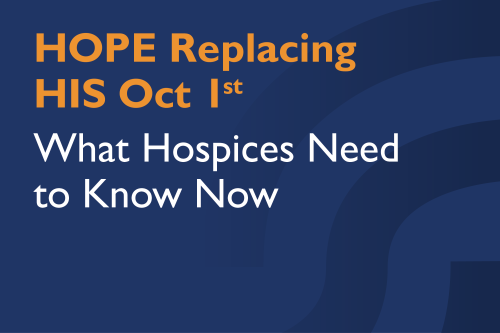Understanding the Transition from HIS to HOPE: What Hospice Agencies Need to Know

Medicare-certified hospices will soon see a major shift in quality reporting standards. Beginning October 1, 2025, the Hospice Item Set (HIS) will be officially replaced by the HOPE tool, or Hospice Outcomes & Patient Evaluation. This upcoming change marks a significant evolution in how hospices collect and report quality data—and it brings a host of operational considerations with it.
If you’re leading a hospice organization, now’s the time to get ahead of what HOPE means for your team, your workflows, and your compliance status. Need help now? Reach out to us for a HOPE meeting today
In this article, we’ll cover:
- The purpose of HOPE and how it differs from HIS
- Why CMS is implementing this update
- Read our recent blog that includes implementation steps
- What compliance will look like under the new model
- Steps your agency should take now to prepare
If you are reading this before July 30th, be sure to sign up for our webinar: HOPE Tool Ready: Seamless Implementation for October 1st.
Understanding the Shift from HIS to HOPE
Since its introduction, HIS has been the standard for hospice quality reporting. It primarily focused on whether certain care tasks—like pain screening or spiritual preference discussions—were completed at the start and end of care. Submitting accurate and timely HIS data was crucial to avoid financial penalties.
However, as hospice providers became uniformly successful at meeting HIS criteria, the system’s ability to differentiate quality across providers diminished. It also lacked the depth needed to evaluate how care impacted patient outcomes.
Enter HOPE.
What Is HOPE?
HOPE is a real-time, patient-centered assessment tool developed by CMS to provide a more detailed picture of care quality. Unlike the retrospective, checklist-style approach of HIS, HOPE is designed to be integrated directly into clinical care delivery.
Key Features of HOPE:
- Conducted at multiple timepoints, including admission, within the first 30 days of care, and at discharge
- Completed during actual patient visits, ensuring real-time data collection
- Captures more nuanced clinical and personal information, such as symptom severity, care preferences, and outcomes
- Supports clinical decision-making, rather than simply reporting on care delivery
By gathering richer, more actionable insights, HOPE aims to both enhance patient care and modernize quality reporting.
Why CMS Is Making the Change
CMS is moving toward a more outcomes-focused model across all post-acute care settings. Instead of tracking whether a task was completed, the emphasis is now on whether care provided led to measurable improvements in patient well-being.
Additional motivations behind the shift to HOPE include:
- Providing better visibility into symptom management
- Supporting meaningful quality comparisons among providers
- Creating a pathway for value-based reimbursement models
- Aligning hospice quality measures with those in home health and skilled nursing
Key Shifts Hospice Providers Should Understand
The transition from HIS to HOPE on October 1, 2025, marks a fundamental change in how hospices assess and report quality care. Here’s what’s changing:
- Retirement of HIS: The Hospice Item Set (HIS) sunsets at the end of September 2025.
- Launch of HOPE: The new Hospice Outcomes & Patient Evaluation (HOPE) tool becomes mandatory for Medicare-certified hospices beginning October 1, 2025.
- More Frequent Assessments: HOPE introduces up to four assessment points per patient, capturing care from multiple angles during the first 30 days and at discharge.
- Real-Time Data Capture: Unlike the retrospective nature of HIS, HOPE assessments are completed during live patient encounters, providing richer and more immediate insights.
- Higher Stakes for Compliance: To avoid a reimbursement cut of up to 4%, agencies must ensure that at least 90% of HOPE assessments are submitted on time—a notable increase from the previous 2% penalty under HIS.
- Public Reporting Timeline: While HIS data has been publicly available, HOPE data will not be released for public comparison until fiscal year 2028 or later, giving providers time to adapt.
Preparing Your Hospice for HOPE
To ensure your agency remains compliant and confident in the face of this change, here’s how to get started:
- Review the HOPE manual from CMS and familiarize your team with the tool’s structure
- Coordinate with your EMR provider to understand integration timelines and training needs
- Update internal workflows to accommodate additional assessments at new timepoints
- Follow CMS updates closely via their website or email bulletins to avoid missing critical changes
HOPE: A New Chapter for Hospice Quality
While the retirement of HIS may feel daunting, HOPE represents a more personalized, data-rich, and clinically relevant approach to evaluating hospice care. It aligns quality reporting more closely with actual patient outcomes and gives providers tools to better plan and adapt care.
Don’t wait for October 2025 to begin your transition. The earlier your agency adopts HOPE-friendly practices, the smoother your rollout will be, and the better positioned you’ll be to meet compliance requirements without disrupting care.
Join our webinar on July 30th for a full walkthrough of everything you need to know to be ‘HOPE Tool Ready!’ If you can’t make it live, register anyway to receive a copy of the recording. Register now!
If you are reading this after July 30th, 2025, the recording is available on our webinars page.
Reach out to us for a HOPE meeting today to explore how we can support your organization through this transition.

